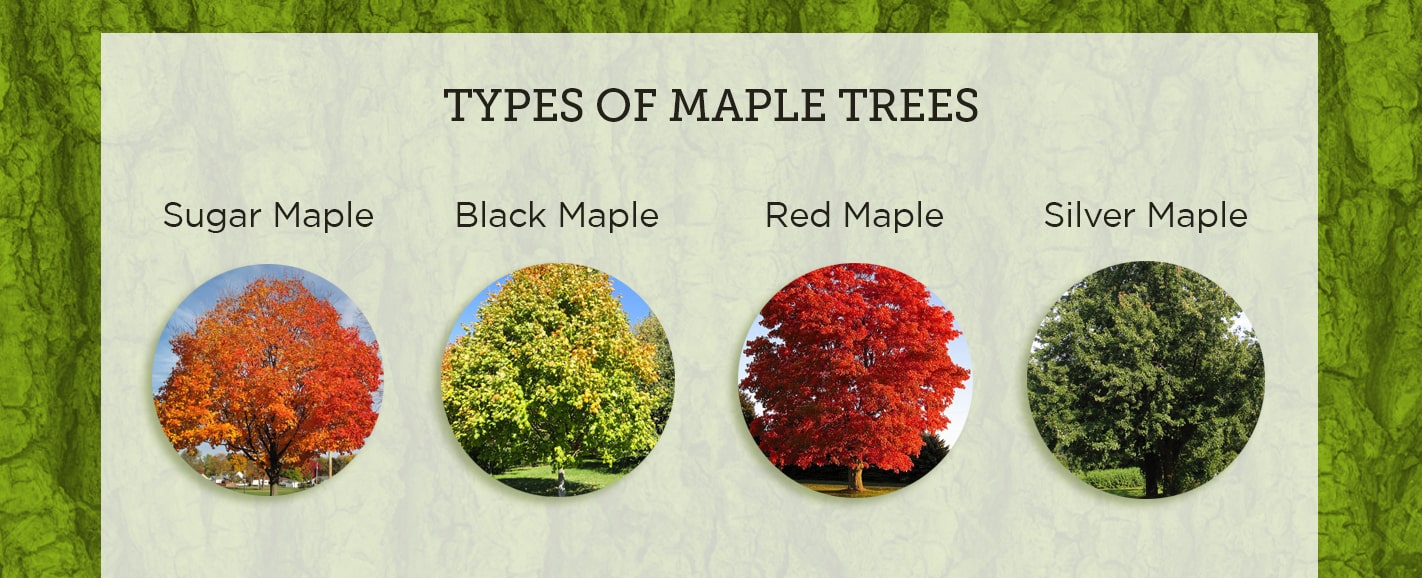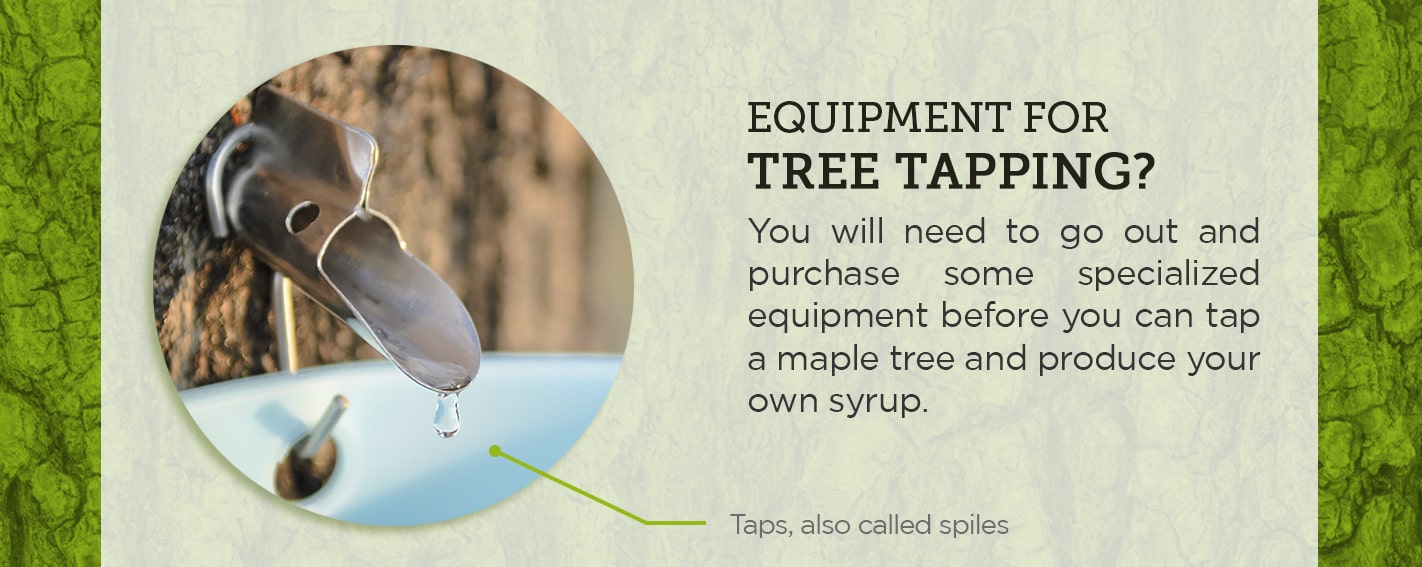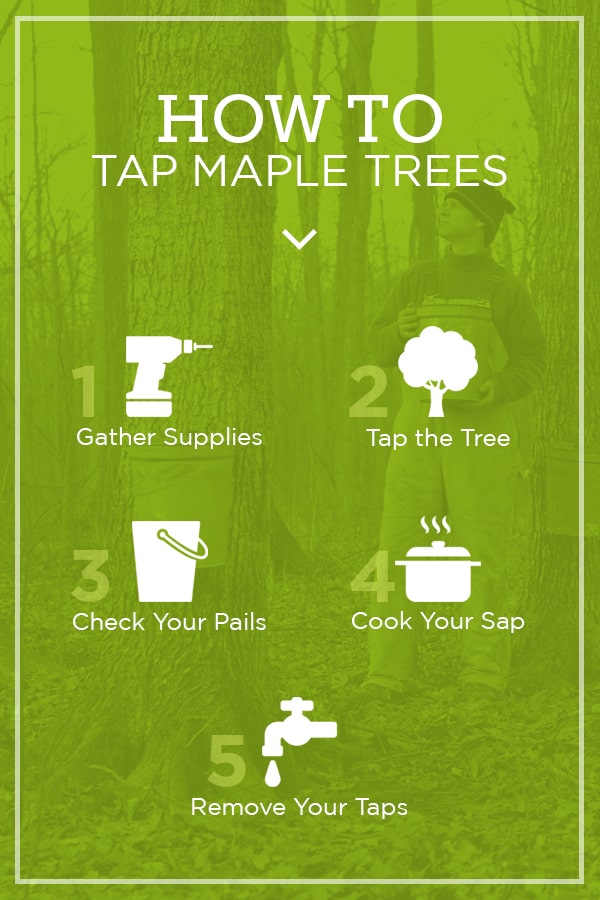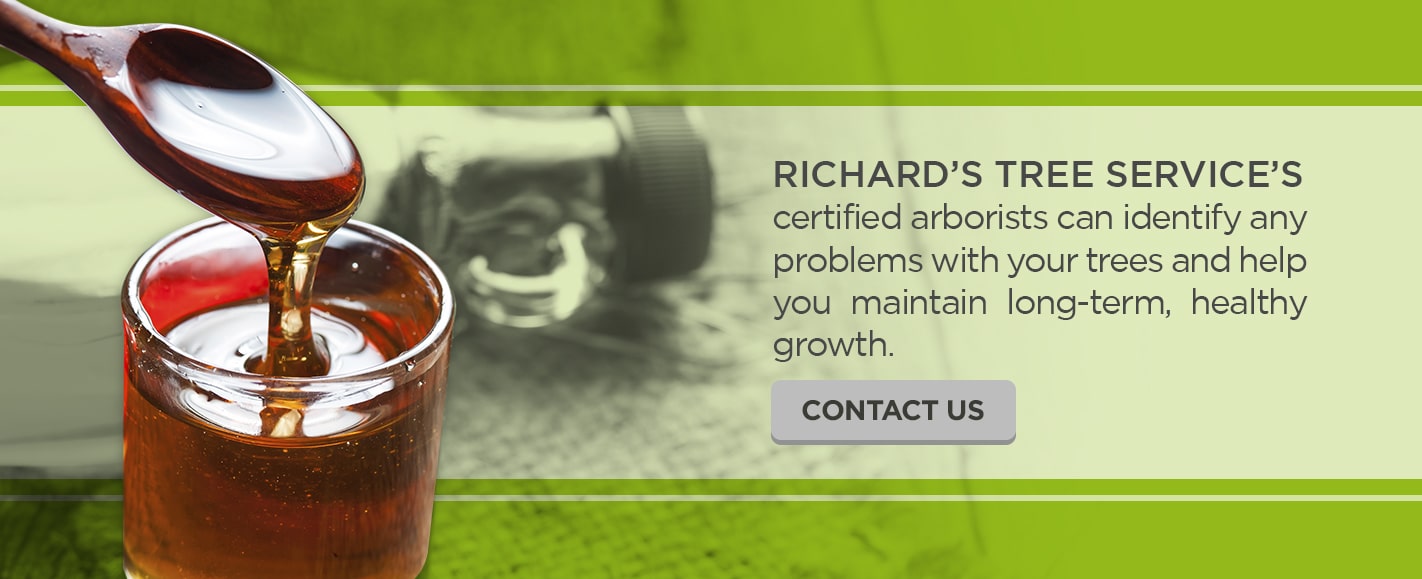
Tapping Maple Trees

Maple syrup adds a sweet touch and a bit of specialness to a plate of waffles, pancakes or French toast. The syrup, which shouldn't be confused with "pancake syrup," adds notes of vanilla and caramel to your breakfast.
What can make maple syrup even more special? Making your own. Although DIY maple syrup can seem like a project that's out of the reach of the average person, the truth is that if you have the right type of trees on or around your property, you can tap them and harvest a supply of sap to turn into golden maple syrup.
If you're going to make your own maple syrup, the first step is to identify maple trees in your yard. Next, you'll want to gather your supplies and get to work tapping the trees. It might sound difficult, but it's not, and the delicious results will be well worth the effort.
What Are the Different Types of Maple Trees?

Before you can make maple syrup, you've got to be familiar with different maple trees. Some maple trees are better for sap collecting than others. Some types of trees will produce better quality or sweeter syrup than others.
It's also worth noting that you want to be able to tell the difference between different species of trees. For example, birch and walnut trees will produce sap that you can use to make syrup, but they won't give you maple syrup. Other types of trees, like oak trees, also produce sap, but you probably don't want to be making syrup from it.
Knowing how to identify a maple tree and the type of tree it is will help you out as you get started on your maple syrup-making project.
1. Sugar Maple
The sugar maple (Acer saccharum) might be the tree that comes to mind when most people think of a maple tree. Like other maples, it's a deciduous tree, meaning it loses its leaves in the fall. Before its leaves fall, they change from green to red, orange or yellow. Even if you're not sure that you've seen a sugar maple in the wild, you've seen a picture of its leaf. The five-lobed leaf has a starring role on the flag of Canada.
Sugar maple leaves are round at the base, usually with five lobes and no fine teeth. The bark starts dark grey and matures to dark brown with vertical ridges. Twigs are slim, shiny and brown, and the fruit of the sugar maple consists of winged seeds that join each other in a straight line and mature in the fall.
Mature sugar maples can be around 100 feet in height with a spread of 80 feet. Depending on the cultivar, the tree can survive in USDA hardiness zones 3 through 8. Sugar maple trees are more sensitive than other varieties and thrive away from sources of pollution and congestion. Because of its large size, the sugar maple also needs plenty of room and should be given ample space when planted. In the right spot, a sugar maple will thrive with little to no care or attention from you.
Identify Maple Trees: Sugar Maple Fast Facts
- Height: Around 100 feet
- Bark color and appearance: Light gray to dark brown with a rough, irregular texture
- Leaves: Five-lobed leaves are dark green on the front and lighter green on the underside
- Fruit: 1-inch long, winged seeds
2. Black Maple
The black maple (Acer nigrum or Acer saccharum ssp. nigrum) has some things in common with the sugar maple. The two types of trees might be so closely related that some people classify the black maple as a subspecies of the sugar maple and not as its own separate species. One of the critical differences between a black maple and a sugar maple is the leaf shape.
While sugar maples have five lobes, black maples have just three. The leaves of the black maple are also slightly thicker than sugar maple leaves and tend to be fuzzy on one side. Twigs tend to have warty protuberances, and the seeds are slightly larger than in the sugar maple.
Identify Maple Trees: Black Maple Fast Facts
- Height: Between 60 and 75 feet
- Bark color and appearance: Gray to black, very deeply ridged and furrowed
- Leaves: Dark green color, changes to yellow in the fall, three lobes
- Fruit: 1-inch long, winged seeds
3. Red Maple
The red maple (Acer rubrum) is sometimes also known as the scarlet maple or swamp maple. Its leaves start out red, turn green, then turn red again in the fall. The red maple tree also has red flowers. The tree is a little shorter than black and sugar maple trees but has similar looking bark. Like the black maple, its leaves are usually three-lobed.
Spring red maple leaves are light green on top with a whitish underside. The bark of the red maple starts light grey and smooth and matures to a darker bark with grey or sometimes black ridges as well as scaly, narrow plates. Twigs are shiny, slim and reddish. When they are broken, they give off an unpleasant odor. The fruit of the red maple is double-winged and matures in spring, rather than in the fall like the sugar and black maples.
The red maple tends to grow faster than sugar maples and also seems to tolerate wetter conditions than other types of maple trees.
Identify Maple Trees: Red Maple Fast Facts
- Height: Between 40 and 60 feet
- Bark color and appearance: Younger red maple trees have light gray, smooth bark. Bark darkens and becomes rougher in texture as the tree matures.
- Leaves: Red, then green, then red again. Three-lobed, although occasionally five-lobed leaves appear.
- Fruit: 1-inch long, winged seeds
The silver maple (Acer saccharinum) is one of the fastest growing maple varieties. It has a very vigorous root system and needs to be planted away from features such as driveways and sewer lines. The silver maple gets its name because its leaves are green on the top surface and whitish-gray on the underside. The leaves have five lobes and turn yellow-green in the fall.
Twigs are like the red maple, although winter buds are slightly larger. Like the red maple, when broken, silver maple twigs give off a noxious smell. Silver maple fruit looks and develops similarly to red maple fruit.
Identify Maple Trees: Silver Maple Fast Facts
- Height: Between 50 and 80 feet
- Bark color and appearance: Smooth and gray when the trees are young. The bark develops into scales or long plates as the trees mature.
- Leaves: Green on top, whitish-silver underside, very pronounced five lobe shape
- Fruit: 2-inch long, winged seeds
How Do You Choose the Type of Maple Tree to Tap?
Does it matter if you tap a sugar, black, red or silver maple tree? Not so much. What matters most when choosing a tree to tap for syrup isn't the variety of maple but the age and size of the tree.
Your maple tree should be at least 10 inches in diameter before you tap it. If you tap a tree that's smaller than 10 inches, you risk killing it, as it's not mature enough to handle the stress of having a hole drilled into it.
The size of the tree determines how many taps you can drill into it and how much sap you're likely to get. You can create one tap in a tree that's between 10 and 20 inches in diameter. You can put two taps into a tree that's between 20 and 25 inches in diameter. Trees above 25 inches in diameter can get up to three taps, but don't put more than three taps into any maple tree, no matter how big it is.
That said, some types of maple tree are going to produce sweet syrup more easily than others. Sugar maples have the highest concentration of sugar in their sap of all maple trees. To produce one gallon of syrup from a sugar maple tree, you need 40 gallons of sap. To make syrup from the sap of other varieties of maple trees, you might need up to 60 gallons of sap for every gallon of syrup produced.
What Equipment Do You Need for Tree Tapping?

Although professional sugarmakers often have tens of thousands of taps and use specialized equipment such as tubing and storage tanks when gathering sap from maple trees, your operation doesn't need to be anywhere as grand or complicated. That said, you will need to go out and purchase some specialized equipment before you can tap a maple tree and produce your own syrup.
The equipment you need includes:
- Taps, also called spiles
- Buckets or other sturdy containers to collect the sap
- Lids for the buckets
- Hooks
- Drill with a 3/8-inch or 7/16-inch drill bit
- Hammer
You'll also need some supplies for turning the sap into syrup once you've collected it:
- Food-safe storage buckets with lids
- Wide, shallow pan such as a roasting pan
- Outdoor, propane burner — boiling the sap indoors tends to make a sticky mess
- Cheesecloth or other material for straining the sap
- Instant-read thermometer
- Bottles for the syrup
When Is the Best Time to Tap a Maple Tree?
Knowing when to tap maple trees for syrup means understanding a bit about the science behind trees and sap. In the cold winter months, maple trees store sugar in the form of starch in their roots. When the weather starts to warm up, the starch converts into sugar, which then dissolves into the tree's sap. Changes in the weather, notably thawing, then freezing temperatures, create pressure in the tree that pulls the sap up into the trunk of the tree.
Usually, the best time to tap a tree is when the temperatures are still freezing or colder at night but warmer during the daytime. In Virginia, the ideal time to tap is usually around mid-February or March. When it's warmer than usual, you might be able to tap trees even earlier in the season. For example, unseasonably warm temperatures in 2017 meant that maple syrup producers were tapping trees in January.
Once the trees are tapped, the sugaring season often lasts for up to six weeks. The season ends when the trees begin to produce leaf buds and when the temperature no longer falls below freezing at night.
How to Tap Maple Trees

Once you've identified the maple trees, the fun can begin. It's time to start tapping. Here's what to do.
1. Gather Supplies
Put the appropriate drill bit in your drill, find your hammer and gather up the spiles, hooks and buckets you'll use to collect the sap.
Once you've gotten your supplies, give them a good cleaning with soap and water and a bit of bleach. You want to disinfect them thoroughly to avoid contaminating your sap.
2. Tap the Maple Tree
The first step to tapping the tree is figuring out where you'll put the tap. The tap can be anywhere from 2 to 4 feet off the ground.
To tap the tree, drill a hole about into the trunk of the tree, either above a large root or below a large branch on the south side of the tree. Hold the drill and drill bit at a slight angle, pointing upwards. The hole should be about two inches deep. You can mark the two-inch point on your drill bit so that you know when you've gone far enough.
After making the hole, clear away any sawdust. Attach the hook to the spile, then push the spile into the hole. Use a hammer to push it in firmly. Avoid whacking the spile too hard, as you don't want to crack the wood of the tree.
Once the spile and hook are in place, hang the bucket from the hook and put the lid on it.
3. Check Your Pails
How long it takes your buckets or pails to fill up with sap depends on how quickly the tree's sap is running. Your buckets might fill up overnight, or they might not even get halfway full after a day as the season goes on. Still, it's a good idea to check your pails daily and to pour any collected sap into a large bucket. You can strain the sap through cheesecloth to remove any debris that might have gotten into it. Store the sap buckets in a cold area and keep them tightly covered.
4. Cook Your Sap
You can either cook your sap all at once or cook it as you go. It depends on how many trees you've tapped and how much sap you've collected. To cook your sap, pour it into a large, shallow pan like a roasting pan and put the pan over the burners of your stove or an outdoor stove.
Bring the sap to a boil. Any water in the sap will evaporate off, turning the sap into a syrup. At this point, it's a good idea to use an instant-read thermometer to monitor the temperature of the sap. When it's still got a high water content, it will boil at 212 degrees Fahrenheit.
Syrup has a higher boiling point than water at 219 degrees Fahrenheit, so as the water evaporates, the temperature will need to get higher before the sap can boil.
5. Remove Your Taps
At the end of the season, you'll want to take the taps out of the trees and store them away for next year. Your trees are finished sugaring when the sap turns cloudy and develops a somewhat bitter flavor. Sugaring season also comes to an end once the trees start budding and temperatures stay above freezing.
Before you pack your supplies away for the year, give them a thorough cleaning and dry them.
How Do You Make Maple Syrup?
Cooking the sap is just the first step towards making finished maple syrup. Once the sap boils down into syrup, you're not quite finished.
The next thing to do is to strain the syrup, removing any sugar particles from it. You can purchase filters that are designed for filtering syrup. After the syrup is strained and filtered, pour it into sterilized bottles for storage. You'll want to pour the syrup while it's hot, so you might need to reheat it if it's cooled down.
Healthy Maple Trees Make the Best Syrup

The most important thing you need to make great maple syrup is healthy maple trees. If you need tree care for your maple trees or other trees on your property, contact Richard’s Tree Service, the most trusted name when it comes to tree companies in northern Virginia. Richard’s Tree Service’s certified arborists can identify any problems with your trees and help you maintain long-term, healthy growth.
If it is an emergency please call us immediately at 703-354-3667.
Use this form to schedule a FREE estimate. After submitting your form, our team will contact you to set up this appointment.
